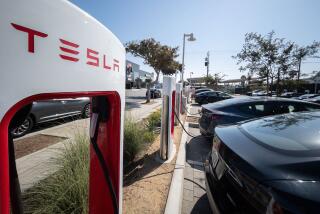Bail out car buyers?
Today’s topic: What’s the point in retooling Detroit when so few consumers are buying cars? Wouldn’t it be better to subsidize new car purchases than to send money directly to the Big Three? Previously, Ikenson and Burtless discussed high labor costs for U.S. automakers, the Big Three’s restructuring plans and whether any domestic car manufacturers should be allowed to slip into bankruptcy.
No bailouts for anyone. Let the market sort this out
Point: Daniel J. Ikenson
A bailout for Detroit would be unfair to taxpayers as well as to the firms in the industry that don’t receive subsidies, and it would distort market signals and incentivize inefficient, unproductive activities at a time when the economy can least afford it. Beyond those principled objections, there is the cold, hard fact that a bailout for these automakers under these circumstances would fail.
The Big Three are losing $6 billion per month collectively, and U.S. automakers are projected to sell even fewer cars in 2009. In other words, the operating losses will only grow. At Thursday’s hearing before the Senate Banking Committee, it became clear that the Big Three’s problems are much deeper than they originally ($25 billion) or subsequently ($34 billion) represented. Economist Mark Zandi -- who was actually testifying in favor of a phased bailout -- projected the full cost of a bailout at $75 billion to $125 billion over two years.
With such overcapacity in the industry already, subsidies to build more capacity or to retool would be an egregious waste of our children’s money. Yet House Speaker Nancy Pelosi still wants to see plans for Big Three investment in high-mileage vehicles, even though Americans will have even less interest in purchasing them as gas prices continue to fall nationwide.
Some raise the point that subsidizing consumption, rather than inefficient production, might be a better approach. I think there is a plausible argument that incentivizing demand behavior is more effective than incentivizing supply behavior to achieve policy outcomes. After all, the end purpose of production is consumption. For example, fuel efficiency standards imposed on auto producers compel them to produce vehicles with low or no profit margins. It hurts their bottom lines. There is only a compliance motive, and no profit motive, in making these kinds of cars. If reducing carbon emissions is an objective of policy, a gas tax would be a more direct (and probably fairer) way of achieving that goal.
Subsidizing demand, though, also carries the potential for perverse and unfair consequences. Someone who might have purchased a bicycle or a particular brand of small vehicle might suddenly be in the market for a larger vehicle from a different producer. Are such subsidies fair to the consumer who purchased a new vehicle last month or last year? Are consumers already swimming in too much debt? Is this an appropriate use of taxpayer dollars?
The best solution is to allow the bankruptcy process to work. It will be needed. There are going to be jobs lost, but there is really nothing policymakers can do about that without exacerbating problems elsewhere. The numbers won’t be as dire as the Big Three have been projecting.
As we eventually emerge from the recession, we need to stop thinking about Honda, Toyota, Nissan and the other foreign-nameplate automakers producing in the United States as non-U.S. companies. After all, they employ American workers, pay U.S. taxes, support local businesses and charities and continue to make investments in U.S. manufacturing. They are the companies leading the way forward. More broadly, we need to recognize that the world economy is no longer characterized as “our producers versus their producers” or “us versus them.”
It’s not so much competition between distinct companies that characterizes commerce in the global economy. It is really a competition between supply chains that tend to comprise value-added activities from multiple countries. Companies are not competing for markets as much as countries are competing for investment and talent. Smart public policy, by which I mean policies that carry few frictions and allow markets to work, will ensure a return to growth and high living standards.
Daniel J. Ikenson is associate director of the Cato Institute’s Center for Trade Policy Studies.
Forget the consumption incentives. First, save the automakers
Counterpoint: Gary Burtless
Like you, Dan, I’m not very enthusiastic about the idea of consumption incentives for car buyers. Many if not most car models are already available at a steep discount. In November, Toyota offered the biggest sales incentives in its history. Nonetheless, Toyota’s U.S. sales were down 40% compared with sales a year earlier. If we give car-buying incentives directly to consumers, automakers will eventually receive a benefit -- their sales and possibly their net price per vehicle will rise. I’m afraid, however, that two of the Big Three automakers would already be in bankruptcy and probably in liquidation before this kind of help would reach them.
Auto companies have to pay wages to their employees. They have to buy parts from other companies to produce new vehicles. To pay their bills, they need money in the bank this week, next week and next month. A surge in sales in February or April would be too late to save General Motors and Chrysler. Banks and private investors aren’t standing in line drooling over the prospect of lending to a U.S. carmaker. That is the reason federal action is needed to keep the automakers alive. And that is also the reason I must disagree with your claim that the best strategy is to “allow the bankruptcy process to work.” It won’t work because lenders are unlikely to make loans to a bankrupt automaker -- unless the government guarantees the loans.
You also say, Dan, that there is nothing policymakers can do without exacerbating problems in the rest of the economy. In the current environment, the failure of an automaker is precisely the event that would exacerbate problems in the rest of the economy. It would worsen the crisis of confidence that is already hurting consumption and strangling private investment. The case for emergency federal action was strengthened by this morning’s job numbers. Last month, U.S. payroll employment dropped by more than 530,000 jobs. In the last three months, payroll rosters have fallen by more than 1.2 million, and the pace of job loss is accelerating. If GM should fail this month or early next year, it would add hundreds of thousands of workers to the ranks of the unemployed.
There are two compelling arguments for providing emergency loans to the Big Three. The first is humanitarian. Do we really want to throw hundreds of thousands of workers into unemployment when the outlook for finding a job is so bleak? Tens of thousands of workers face layoffs even if the federal government throws a lifeline to the Big Three.
As I have emphasized throughout this debate, any emergency loan must require that automakers offer a feasible business plan, one that maps out a believable route to eventual profitability. To become profitable, an automaker would have to cut its payrolls, seek relief from its creditors and scale back its dealership network. Tens of thousands of jobs would be lost even if the automaker is ultimately saved.
You assure us, Dan, that layoffs from a bankruptcy won’t be as bad as the automakers tell us. You are betting that without a federal loan, some carmakers will be able to continue operating, on a reduced scale, after they’re bankrupt. I think total liquidation of GM or Chrysler is the more likely scenario. My fear is that hundreds of thousands of jobs will be permanently and needlessly lost if we allow one or more of these companies to enter bankruptcy (and eventually liquidation).
A second argument for an emergency loan is simple self interest. The economy is already losing more than 400,000 jobs a month. Private consumption is sinking. Investors are leery of placing their money in any security more risky than a Treasury bond. In these circumstances, the failure of one or more of the Big Three would inflict a terrific blow to consumer and investor confidence. Even if the economy were growing smoothly, the collapse of one of the Big Three would cause major problems for local economies. Tens of thousands of laid-off workers would suffer unemployment and be forced to accept pay cuts to get re-employed. The pain and the spillover effects are much more severe when joblessness is already high and rising.
Dan, even if you despise the U.S. automakers and the United Auto Workers, as you seem to, you should think hard about the consequences of letting one or all of the automakers totally collapse. You are confident that the economy will eventually recover and the auto industry will become smaller and more efficient. Over the next three or four years, however, I think both you and our readers should ponder some basic questions. What would a carmaker’s collapse mean for your own chances of finding a job, getting a raise, keeping a job you already have or seeing an improvement in your 401(k) balances?
With a well-designed federal loan, the auto industry would get smaller, more efficient and profitable. The pain of adjustment and the scale of the job loss from the industry’s reorganization will be a great deal smaller if we provide government loans to the Big Three than if we let them disappear.
Gary Burtless, a senior fellow at the Brookings Institution, served in the Carter administration as a staff economist for the Department of Labor and the Department of Health, Education and Welfare.
More to Read
A cure for the common opinion
Get thought-provoking perspectives with our weekly newsletter.
You may occasionally receive promotional content from the Los Angeles Times.






